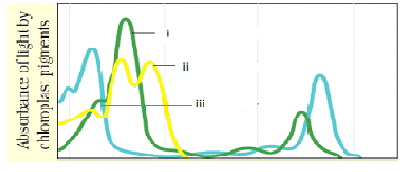Where does photosynthesis takes place?
a. in green leaves
b. in green parts of plant
c. in leaves
d. in complete plant
a. in green leaves
b. in green parts of plant
c. in leaves
d. in complete plant
The _____________ in the leaves have a large number of_________, which align themselves along the walls of the ____________, such that they get the __________quantity of the incident light.
| 1. | chloroplasts, chlorophyll, chloroplasts, optimum. |
| 2. | mesophyll cells, chlorophyll, mesophyll cells, optimum. |
| 3. | mesophyll cells, chloroplasts, mesophyll cells, optimum. |
| 4. | mesophyll cells, chloroplasts, mesophyll cells, minimum. |
Identify i, ii, iii and iv labellings in the following diagram :

| i | ii | iii | iv | |
| 1. | stroma lamella | thylakoid | stroma | genetic material |
| 2. | stroma lamella | grana | stroma | starch granule |
| 3. | grana | lamella | stroma | starch granule |
| 4. | stroma lamella | grana | cytoplasm | starch granule |
| Column I | Column II |
| i. grana | a. dark reaction |
| ii. Stroma | b. light reaction |
| c. synthesis of ATP and NADPH+H+ | |
| d. synthesis of sugar |
| 1. | i-b, c; ii-a, d. |
| 2. | i-a, d; ii-b, c. |
| 3. | i-b, d; ii-a,c. |
| 4. | i-b; ii-a, c, d. |
How many of the following statements are correct?
| i. | Products of dark reaction are substrates of light reaction. |
| ii. | Products of light reaction are substrates of dark reaction. |
| iii. | In the stroma, enzymatic reactions incorporate CO2 into the plant leading to the synthesis of sugar. |
| iv. | Dark reactions are directly light-driven. |
| v. | Chloroplast is a single membranous organelle. |
1. 2
2. 3
3. 4
4. 1
Products of light reaction does not include-
a. ATP & NADPH
b. CO2
c. O2
d. Electrons
Absorption spectrum of chlorophyll- ‘a’ is shown by-

1. I
2. II
3. III
4. Not shown.
How many pigments are responsible for the color of a plant leaf?
a. 1
b. 2
c. 3
d. 4
After performing the chromatographic separation of a plant leaf, experimentor found bright or blue green colour in the chromatogram. Then this pigment should be-
a. xanthophyll
b. carotenoid
c. chlorophyll a
d. chlorophyll b.
Range of wavelength at which chlorophyll-a shows the maximum absorption:
a. 400-450 nm
b. 450-500 nm
c. 650-700 nm
d. 500-600 nm.






